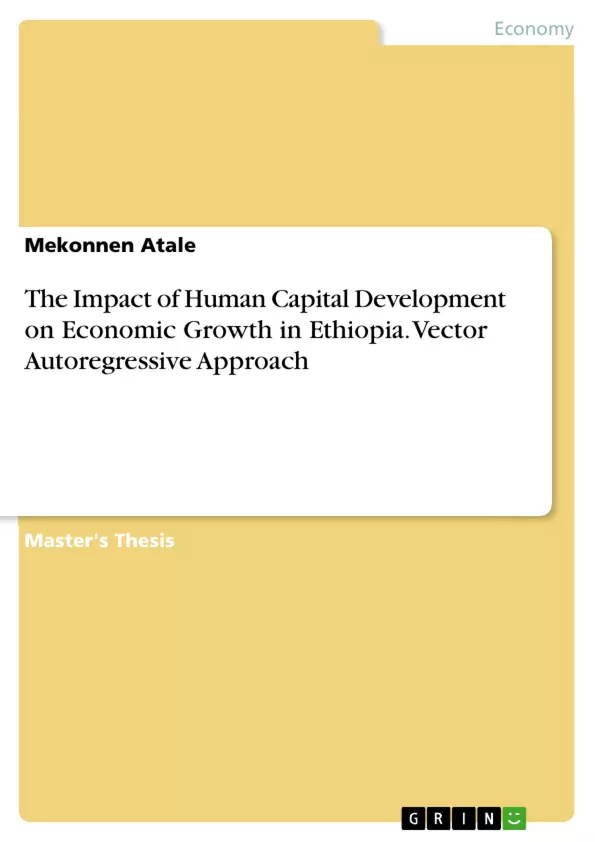The main objective of this study is to investigate the short run and the long run impact of human capital development on economic growth in Ethiopia over the period 1975-2020. The human capital development proxies are education and health expenditures to ratio of GDP, labor force participation and secondary education enrollment ratio, while real GDP per capita is a proxy variable of economic growth. The study applied Johnson Maximum Likelihood co-integration test and error correction mechanism to identify the impact of human capital development on Economic growth both in the long run and short run.
The finding reveal that human capital development proxies (secondary education enrollment rate and public health spending to share of GDP) and labor force exhibit negative and significant effect on economic growth in the long run, while government expenditure on education exhibits positive and significant effect on economic growth in the long run. Hence, education spending is the main contributor of real GDP per capita in the long run. However, health spending did not contribute to human capital development and economic growth in the long run.
Inhaltsverzeichnis (Table of Contents)
- ACKNOWLEDGEMENT
- LIST OF TABLES.
- LIST OF TABLES IN APPENDEX.
- LIST OF FIGURES
- LIST OF ACRONYMS
- Abstract...
- CHAPTER ONE
- 1. INTRODUCTION.
- 1.1. Background of the study.
- 1.2 Statement of the problem......
- 1.3. Objectives of the Study.
- 1.3.1 General Objective..
- 1.3.2. Specific objectives:
- 1.4 Research Questions .......
- 1.5. Significance of the Study..
- 1.6. Scope of the study.
- 1.7. Limitation of the study.....
- 1.8. Organization of the paper..
- 1. 9. Operational Definitions and key terms
- CHAPTER TWO
- 2. RELATED LETRATURE REVIEW.
- 2.1. Theoretical review
- 2.1.1 Human capital theory.
- 2.1.2. Endogenous Growth theory and Human capital
- 2.1.3. Education and Economic growth.
- 2.1.4. Health and economic growth.
- 2.1.5. Rationale Investments on Education and Health
- 2.1.6. Measuring Human capital Development.......
- 2.2. Empirical Literature .
- 2.3. Research gaps......
- 2.4. Conceptual framework...
- CHAPTER THREE
- 3. OVERVIEW OF HEALTH AND EDUCATION POLICIES IN ETHIOPIA ......
- 3.1. Health Policy in Ethiopia..
- 3.2. Education Policy in Ethiopia
- 3.3. Human capital Development in Ethiopia..
- CHAPTER FOUR…………………………………..\n
- 4. RESEARCH METHODOLOGY.......
- 4.1. Research approach.
- 4.2. Research design
- 4.3. Data sources.
- 4.4. Model Specification.......
- 4.5. Description of variables
- 4.6. Methods of data Analysis...\n
- 4.6.2. Econometric Analysis ....
- 4.6.2.1. Augmented Dicky-Fuller (ADF) Test .
- 4.6.2.2. Cointegration
- 4.6.2.3. Vector Error Correction Mechanism (VECM)
- 4.7. Diagnostic tests.
- CHAPTER FIVE
- 5. RESULTS AND DISCUSSION.
- 5.1. Descriptive statistic results
- 5.1.1. Summary of statistics
- 5.1.2 Trends of Public Spending on Education and Health in Ethiopia.......
- 5.1.3 Trends Life expectancy and Death rate.....
- 5.1.4 Trend of Gross School enrollment rate in Ethiopia
- 5.1.5. Trends of Real GDP and real GDP Per-capita growth in Ethiopia.
- 5.2. Econometrics estimation procedure
- 5.2.1 Augmente Dicky Fuller.
- 5.2.2 Vector Autoregressive (VAR) Estimation
- 5.2.3. Cointegration Test
- 5.2.4. Vector Error Correction Model
- 5.2.5. Long run stability test.
- 5.3. Diagonestic tests.
- 5.3.1 Short run Stability tests
- 5.3.2. Test for Residual Authocorrelation
- 5.3.3. Test for Residual Normality.
- 5.3.4. Test for heteroskedasticity..
- 5.3.5. Test for omitting variable
Zielsetzung und Themenschwerpunkte (Objectives and Key Themes)
This research thesis aims to investigate the impact of human capital development on economic growth in Ethiopia. The study employs a Vector Autoregressive (VAR) approach to analyze the relationship between key variables like education, health, and economic growth.
- Impact of Human Capital Development on Economic Growth
- Role of Education and Health in Economic Growth
- Application of Vector Autoregressive (VAR) Methodology
- Empirical Analysis of Ethiopian Economic Data
- Policy Implications for Human Capital Development in Ethiopia
Zusammenfassung der Kapitel (Chapter Summaries)
Chapter One provides an introduction to the research, outlining the background, problem statement, objectives, research questions, significance, scope, limitations, and organization of the study. It also defines key terms and operational definitions.
Chapter Two delves into a review of relevant literature, covering both theoretical and empirical aspects. It examines human capital theory, endogenous growth theory, the relationship between education and economic growth, the connection between health and economic growth, rationale investments in education and health, and methodologies for measuring human capital development.
Chapter Three provides an overview of health and education policies in Ethiopia. It analyzes the country's health policy, education policy, and the broader context of human capital development in Ethiopia.
Chapter Four details the research methodology, outlining the research approach, design, data sources, model specification, variable descriptions, and methods of data analysis. The chapter discusses econometric analysis, including the Augmented Dicky-Fuller test, cointegration, and the Vector Error Correction Mechanism.
Schlüsselwörter (Keywords)
The main keywords and focus topics of this research thesis include human capital development, economic growth, Ethiopia, Vector Autoregressive (VAR) approach, education, health, public spending, econometrics, cointegration, and policy implications.
- Quote paper
- Mekonnen Atale (Author), 2022, The Impact of Human Capital Development on Economic Growth in Ethiopia. Vector Autoregressive Approach, Munich, GRIN Verlag, https://www.grin.com/document/1383468



